
a.
To determine: The population of Mexico City surpass the population of United States by using the exponential growth model and fined the year, if surpassed.
The population surpasses in the year 2133.
Given Information:
The table is defined as,
| Year | Population |
| 1900 | |
| 1950 | |
| 1960 | |
| 1970 | |
| 1980 | |
| 1990 | |
| 2001 | |
| 2011 | 115 |
| 2016 |
Calculation:
Consider the given polynomial,
Using a graphing calculator, enter the year values starting from
Step 1. Press the tables’ option and enter the values as mentioned above.
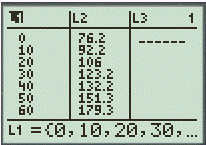
Step 2. Use the Logistic feature to find the exponential regression model.
Display values are following as,

Thus, the function can be written as following,
Similarly, find the exponential model by using the calculator.
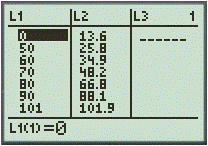
Now, use Logistic function to find the exponential regression model.

Thus, the function can be written as following,
Now, draw both the function o graphing calculator. Set the window of the calculator as following,
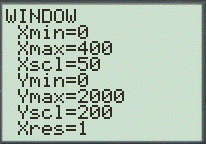
Now, draw both the obtained result.
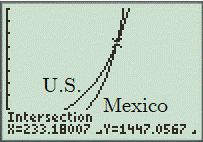
This implies that graph the exponential models on the same viewing window which shows that they intersect at the point
Therefore, the population surpass in the year 2133.
b.
To determine: The population of Mexico City surpass the population of United States by using the logistic model and fined the year, if surpassed.
The population do not surpass in logistic model.
Given Information:
The table is defined as,
| Year | Population |
| 1900 | |
| 1950 | |
| 1960 | |
| 1970 | |
| 1980 | |
| 1990 | |
| 2001 | |
| 2011 | 115 |
| 2016 |
Explanation:
Consider the given information,
Using a graphing calculator, enter the year values starting from
Step 1. Press the tables’ option and enter the values as mentioned above.

Step 2. Use the Logistic feature to find the exponential regression model.
Display values are following as,
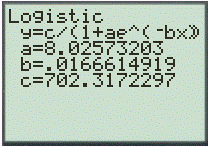
Thus, the function can be written as following,
Similarly, find the exponential model by using the calculator.
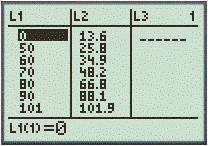
Now, use Logistic function to find the exponential regression model.
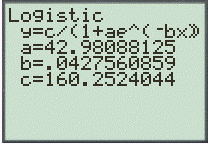
Thus, the function can be written as following,
Now, draw both the function o graphing calculator. Set the window of the calculator as following,

Now, draw both the obtained result.

Graph the logistic models on the same viewing window which shows that they never intersect. Thus, Mexico's population will never surpass the United States' population.
Therefore, the population do not surpass in logistic model.
c.
To determine: The maximum sustainable population for the both countries.
The population is
Given Information:
The table is defined as,
| Year | Population |
| 1900 | |
| 1950 | |
| 1960 | |
| 1970 | |
| 1980 | |
| 1990 | |
| 2001 | |
| 2011 | 115 |
| 2016 |
Explanation:
Consider the given information,
Refer the both model form the previous part (b).
The united state population model is defined as,
And the Mexico city population model is defined as,
By taking the c -values of the both models (numerator values and denominator as 1), the maximum sustainable populations are about 702.32 million for the United States and about 160.25 million for Mexico.
Therefore, the population is
d.
To determine: The model from both type is more valid in the given case and explain your answer.
The required model is logistic model.
Given Information:
The table is defined as,
| Year | Population |
| 1900 | |
| 1950 | |
| 1960 | |
| 1970 | |
| 1980 | |
| 1990 | |
| 2001 | |
| 2011 | 115 |
| 2016 |
Explanation:
Consider the given information,
Refer the both model form the previous part (b).
The united state population model is defined as,
And,
And the Mexico City population model is defined as,
And,
Therefore, the logistic models seem to be more valid as the growth rate of Mexico is smaller than the United States.
Chapter 3 Solutions
PRECALCULUS:GRAPHICAL,...-NASTA ED.
 Calculus: Early TranscendentalsCalculusISBN:9781285741550Author:James StewartPublisher:Cengage Learning
Calculus: Early TranscendentalsCalculusISBN:9781285741550Author:James StewartPublisher:Cengage Learning Thomas' Calculus (14th Edition)CalculusISBN:9780134438986Author:Joel R. Hass, Christopher E. Heil, Maurice D. WeirPublisher:PEARSON
Thomas' Calculus (14th Edition)CalculusISBN:9780134438986Author:Joel R. Hass, Christopher E. Heil, Maurice D. WeirPublisher:PEARSON Calculus: Early Transcendentals (3rd Edition)CalculusISBN:9780134763644Author:William L. Briggs, Lyle Cochran, Bernard Gillett, Eric SchulzPublisher:PEARSON
Calculus: Early Transcendentals (3rd Edition)CalculusISBN:9780134763644Author:William L. Briggs, Lyle Cochran, Bernard Gillett, Eric SchulzPublisher:PEARSON Calculus: Early TranscendentalsCalculusISBN:9781319050740Author:Jon Rogawski, Colin Adams, Robert FranzosaPublisher:W. H. Freeman
Calculus: Early TranscendentalsCalculusISBN:9781319050740Author:Jon Rogawski, Colin Adams, Robert FranzosaPublisher:W. H. Freeman
 Calculus: Early Transcendental FunctionsCalculusISBN:9781337552516Author:Ron Larson, Bruce H. EdwardsPublisher:Cengage Learning
Calculus: Early Transcendental FunctionsCalculusISBN:9781337552516Author:Ron Larson, Bruce H. EdwardsPublisher:Cengage Learning





